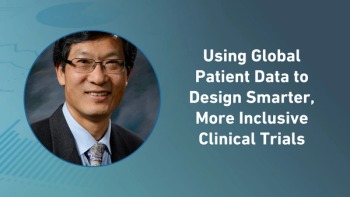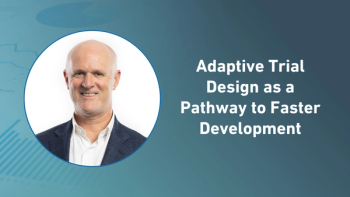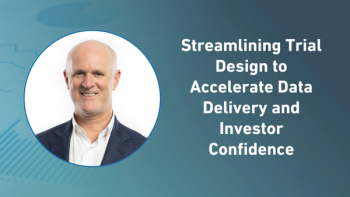
The Importance of Medical Monitoring in Clinical Development: The Past, Present and Future
A look at the positive impact shifting to a patient-centric, data-led approach can have on clinical development through the lens of medical monitoring.
In the past two decades, the cost of clinical trials and the total cost of drug development has continued to rise. Yet, despite advances in R&D technology, the success rate of trials is not increasing at the same pace. Currently, the average cost of a Phase III trial is US $19 million,1 with the average cost of a clinical trial per patient at $311,000.2 One way to optimize clinical development is through focusing on the patient. The primary aim is to put the patient first and reduce the burden on them. With the patient at the center and utilizing a precision medicine approach, each patient and their circumstances is reviewed individually.
In this article, we look at the positive impact that shifting to a data-led and patient-centric approach can have on clinical development through the lens of medical monitoring. Medical monitors are the patient centric ‘tsars’; providing input into the design and conduct of the clinical trials, assessing and interpreting safety and other medically relevant data during the trial, and contributing to investigator and study team training. As a consequence, medical monitoring not only improves data quality, but also contributes to preventing the occurrence of medically relevant protocol deviations and detecting potential safety signals, both at the individual patient and at the trial level. The entire clinical development model is currently undergoing a seismic shift propelled by COVID-19, and medical monitoring is no exception.
The relationship between patient centricity and medical monitoring
Medical monitoring in clinical development has evolved dramatically since the millennium. The role of a medical monitor has become much more strategic and is fundamental to maintaining a patient-centered outlook. The ICH Guideline for Good Clinical Practice E6(R2) advises that “…the sponsor should implement a system to manage quality throughout all stages of the trial process. Sponsors should focus on trial activities essential to ensuring human subject protection and the reliability of trial results.”3
Medical monitoring activities before, during and after a trial include those that require specific medical knowledge, are performed to ensure patient safety and trial data integrity and are performed from regulatory study approval to database lock, inclusive. To fulfill these requirements with the requisite knowledge, medical monitoring activities must be carried out by someone with medical expertise who can accurately interpret trial data. At Alfasigma, all medical monitoring tasks, before, during and after a trial are performed by medical trained professionals who are licensed physicians.
Today, it isn’t common practice nor is it compulsory for pharmaceutical companies or CROs running clinical trials to employ medical experts in the monitoring role. This can present a significant risk factor. For example, in many trials there will be patients who are a great fit for the study but don’t quite meet one of the inclusion criteria, such as if their hemoglobin is borderline below the lower limit. In this instance a physician is essential to be able to interpret the levels in context and understand if they can be included, and if so, whether the criteria for the study as a whole should be altered. In addition, digital technologies exist that can further strengthen and augment medical monitoring; allowing experts to focus on interpretation of data rather than its collection.
To understand how the role of medical monitoring has shifted over the past two decades we are going to review the three essential pillars of medical monitoring, and explore the past, present and future of the discipline, looking at its evolution and role in patient-centric trials.
The three pillars of medical monitoring
With medical knowledge as the foundation of medical monitoring, there are three pillars of quality that should also be kept in mind: quality by design, critical to quality, and quality by deployment.
The aim of quality by design is that clinical trials must focus on good design and execution to prevent overreliance on retrospective checking, monitoring, auditing, or inspection. This concept is outlined in detail within the ICH guidance E8(R1) General Considerations for Clinical Studies.4 Good planning will ensure proper selection of the outcome measures and patient populations, as well as minimizing the burden to sites and patients. Physicians must design the study to minimize the risk of bias and ensure internal validity, in collaboration with clinical scientists and statisticians. Ideally, medical monitors, as medically trained professionals, should provide input at the stage of trial and eCRF (case report form) design, to help address issues that may affect the safety of the patients. Crucial safety and efficacy information should also be easily assessable and accessible during the monitoring activity.
Critical to quality factors must also be defined before a study. If the integrity of a trial is undermined by errors of design or conduct it could jeopardize the reliability and ethics of decision making. A culture that supports open dialogue and critical thinking must be created in the industry and within individual sponsor companies. This enables medical monitors to go beyond sole reliance on tools and checklists and enable them to focus on the patient, their medical history and clinical status.
Quality by deployment is the final pillar which ensures the rules and practices put in place are followed throughout the trial. This should also include physicians working with a separate audit team, independent from the study team, to ensure any elements that aren’t working, or don’t prioritize patient safety, are adjusted as needed to ensure trial success.
The evolution of medical monitoring
Past: manual and paper-based processes dominate: pre-2000. Medical monitoring at this time was much more directly involved with sites and patients; typically monitors would travel between sites more than half of the time. Most of the work was carried out physically and included manually reviewing the source documents, data listings and CRF to see if the medical aspects of the trial were conducted properly. This made it difficult to see the “big picture” of the trial while it was being conducted or to see wider patient trends. The medical monitoring of a trial was also performed quite late in the trial process, as monitors had to wait for sites to fill in the paper CRFs, monitors collected the CRFs, data managers entered the data and created the data clarification form (if required) to be sent to the sites, and then finally the data managers or statisticians created the listings for medical monitoring. There was almost no opportunity to intervene during a trial. These methods also increased the risk of human error, being more time consuming and not cost-effective.
Past: technology shifted the goal posts: 2000s–2019. As technology (particularly Electronic Data Capture (EDC)) progressed in the early 2000s, medical monitoring became more remote. This enabled monitors to access data directly from the database—although not in real time—to set up online checks to help investigators to enter the data. This helped to remove some of the previous errors and increase the speed of data entry and data cleaning. While this technology provided many advantages over the previous manual processes, it was still a little too removed from the patient.
There were still many further improvements required. The introduction of EDC also gave the incorrect impression that the data review could be “delegated” to data managers and statisticians. Access to data from sites was delayed and reported slowly, meaning that monitors were regularly looking at a ‘mirror’ of what the sites were doing. This resulted in inaccuracies, potentially jeopardizing patient safety in the process. In some large pharmaceutical companies, the importance and role of the medical monitor was questioned. This resulted in much of the work being carried out by data specialists and statisticians, rather than medically trained professionals. To shift this culture and emphasize the value of medical monitors, the FDA called for corrective action to improve accuracy.
Present: on the edge of the next revolution: 2020s. Today, the medical monitoring field is on the cusp of another change. The industry is moving towards clinical trials where medical monitoring is much closer to patients, with clinical data readily available at physicians’ fingertips to add context to the patient. In part this has been enabled by the use of portable and wearable devices, and access to real-time data. The authors welcome these changes.
This move towards patient-centricity and the increased deployment of digital technologies, must be embedded at the planning stage of a trial. Predictive analytics ensure patient centered study design—thus improving participant retention rates and lightening the load on the medical monitor so they can focus on patient safety. A medically trained professional is also essential as they can interpret and analyze the medical data, foreseeing potential safety concerns. These safety concerns can be overlooked if a data scientist or statistician is in this position (rather than a physician) as they are unable to review the data with the correct clinical context. Context is essential. On average it costs $6,5335 to recruit one patient to a clinical study; reducing patient burden and improving retention rates can have a huge effect on not only the cost and speed of trials, but also the safety of the patient. Embracing quality by design, critical to quality and quality by deployment is essential for this change and to ensure patients receive the right solution for their medical need.
Future: looking to the next decade: 2021—to 2030 and beyond. In the future, medical monitoring should be augmented with:
- Real time data on patients
- Relevant synthetic patient safety data from previous trials and routine use of predictive clinical data sciences
- Data on sites as a whole
These data can be used to develop box plots, shift tables, outside normal limits, Hy’s Law, predictive trends of safety or efficacy, Serious Adverse Event (SAE) listings and reports. The data sets can also all be augmented with data from wearables, images and, ideally, instant messaging with patients, assuming we overcome some elements of current privacy guidelines. The volume of data available is only going to continue to grow rapidly, creating accurate filtering mechanisms will be the only way to ensure intelligence can be gleaned from it. As such, machine learning and AI algorithms will also be implemented to improve assessment of data in real-time to detect safety signals before any human-led analysis takes place.
Medical monitors themselves must also have the following skills, alongside medical expertise:
- Knowledge of Good Clinical Practice and Regulations
- Critical thinking
- Flexibility
- identify risks before they impact medical data.
- Ability to collaborate with vendors and other Research-associates
- Educate the project team
- Accelerate decision cycles
The medical monitor should have the ability to review individual patient data and data summaries, receive alerts and apply safety modeling, all in real time. These tools would be predictive for medical monitors, highlighting safety data trends before it even meets criteria to be formally flagged. For example, a trending increase in blood pressure or increases in liver enzymes. Fully integrated synthetic data from previous similar trials, adverse events and electronic health records can make this a reality, augmenting the data available from the trial participant to bring to light broader trends. This data could also be utilized to minimize the number of patients receiving placebos as well as to better predict the expected placebo effect. These approaches should apply at both the individual patient level and the aggregate level to check for any abnormal trends or repeated safety events. All such events will be passed through the experienced, medically trained monitor.
More intelligent, data led medical monitoring would also enable a two-way conversation with sites where both sides are able to ask questions and improve trial implementation. Predictive analysis can be used preemptively to define the expected incidence of AEs, use of concomitant medications, expected enrolment rate, and current enrolment, showing which sites might need further support and attention from medical monitors during a trial.
Making the shift a reality
Medical monitoring has evolved in part due to the advances in technology and increased volume of data available to assist physicians. Access to ongoing and real-time data, which can be analyzed at speed is enabling the next step forward in the field. However, we must ensure that medical expertise and experience are at the core of medical monitoring. Safer trials and decreasing the burden on patients will become an increasing focus over the next few years. The drug development and commercialization model is changing, and the role of a medically qualified monitor will be instrumental to make this happen. By adopting patient centric best practices, we can make this the industry norm but strong, medically qualified liaison with the sites will be required.
Michelangelo Barone, MD, is a Clinical Science Director, Global Head, Corporate R&D; Alessandro Blè, MD, is a Senior Clinical Research Physician, Corporate R&D; Chiara Costantini, MSc, is the Biostatistics, Clinical Data Management & Clinical System Head, Corporate R&D; all of Alfasigma. Dr Gen Li is the CEO and Founder; Dr Paul Chew is the Chief Medical Officer; both of Phesi
References
- Why Are Clinical Trials of New Drugs So Expensive? SRG. (2019)
https://www.srgtalent.com/blog/why-are-clinical-trials-of-new-drugs-so-expensive - Mikulic, M, Estimated clinical trial cost per patient by therapeutic class. Statista (2021)
https://www.statista.com/statistics/1197095/clinical-trial-cost-per-patient-by-therapy-area/ - ICH guideline E8 (R1) on general considerations for clinical studies. (2019).
https://www.ema.europa.eu/en/documents/scientific-guideline/draft-ich-guideline-e8-r1-general-considerations-clinical-studies-step-2b_en.pdf - ICH guideline E8 (R1) on general considerations for clinical studies. (2019).
https://www.ema.europa.eu/en/documents/scientific-guideline/draft-ich-guideline-e8-r1-general-considerations-clinical-studies-step-2b_en.pdf - Nicoli-Carr, V. (2020). The True Cost Of Patient Drop-outs In Clinical Trials - MDgroup.
https://mdgroup.com/blog/the-true-cost-of-patient-drop-outs-in-clinical-trials/
Newsletter
Stay current in clinical research with Applied Clinical Trials, providing expert insights, regulatory updates, and practical strategies for successful clinical trial design and execution.






.png)



.png)



.png)
.png)
